Item 2
LP – 2575
BOROUGH OF BROOKLYN
EMPIRE STATE DAIRY COMPANY BUILDINGS, 2840 Atlantic Avenue
Thank you for hearing public testimony today. HDC wishes to reiterate its support for the designation of the Empire State Dairy, and to thank the LPC for moving forward to consider this landmark-worthy complex. The buildings are threatened by the city’s rezoning plans, especially due to their presence on Atlantic Avenue, where increased bulk is being encouraged. The complex is listed in the Environmental Impact Statement as a projected development site, which makes this designation all the more imperative and symbolic. The agency is pursuing designation in part because the buildings have become endangered, and we applaud this effort. In a neighborhood that has only three designated landmarks, this designation would send a strong message to residents about the importance of their neighborhood anchors. An even stronger message would be to take further actions to designate more of East New York’s significant structures so that the city celebrates this vibrant community’s past while also planning for its future.

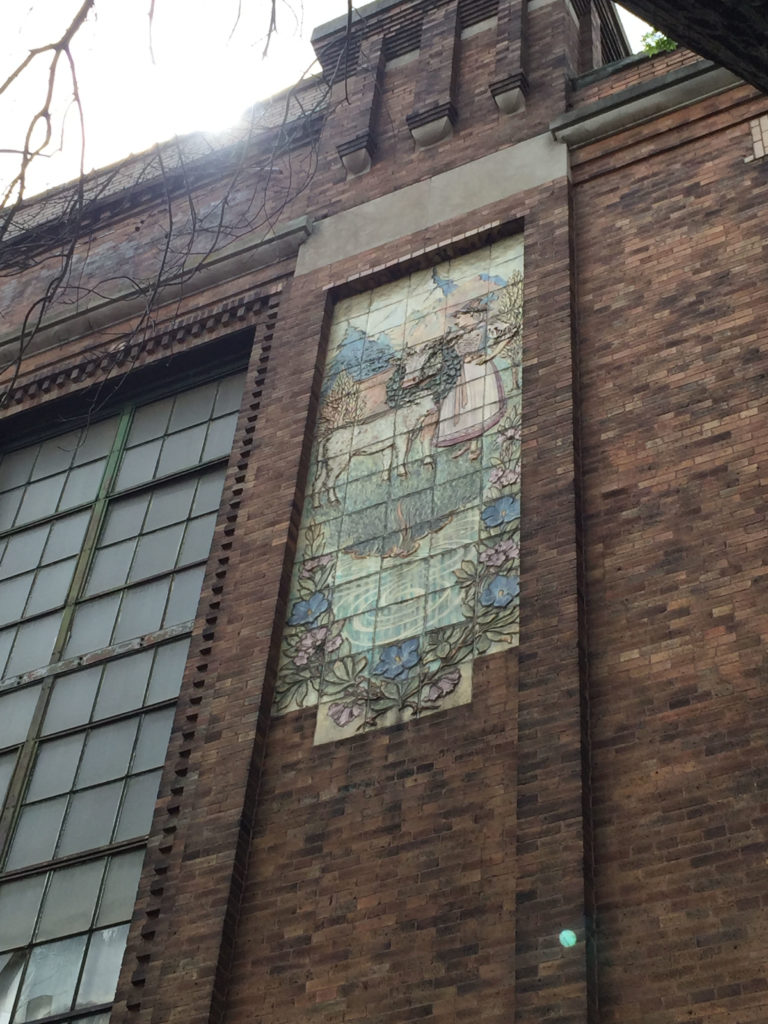
Item 3
LP – 2577
BOROUGH OF MANHATTAN, block 1290, lot 14
MINNIE E. YOUNG RESIDENCE, 19 East 54th Street
The austere, granite façade of 19 East 54th Street is quite a surprise when compared with the ornate Beaux-Arts designs for which the architectural firm of Hiss & Weekes is best known, most notably the Gotham Hotel. For the widowed Minnie Young, Hiss & Weekes designed a restrained Italian Renaissance inspired town house with a central entrance, pedimented piano nobile windows, and a deep cornice. The openings in the granite facade are crisply cut and virtually devoid of applied decoration. Completed in 1899, the house was originally occupied by Minnie Young and her sister, Joanne B. Arents, along with a significant number of servants – nine in 1900 and seven in 1910. As the neighborhood changed, the house was converted for commercial use, which explains the presence of display windows on the first floor. One notable period in its commercial life was the 1960s, when the building housed the prestigious Kenneth Beauty Salon, which counted Jacqueline Kennedy as a client. Today, the building stands as a rare reminder of East Midtown’s once residential use and character, and as a fine architectural example of such. The fact of its survival and longevity in an ever-changing midtown context is reason enough to grant the building landmark status.
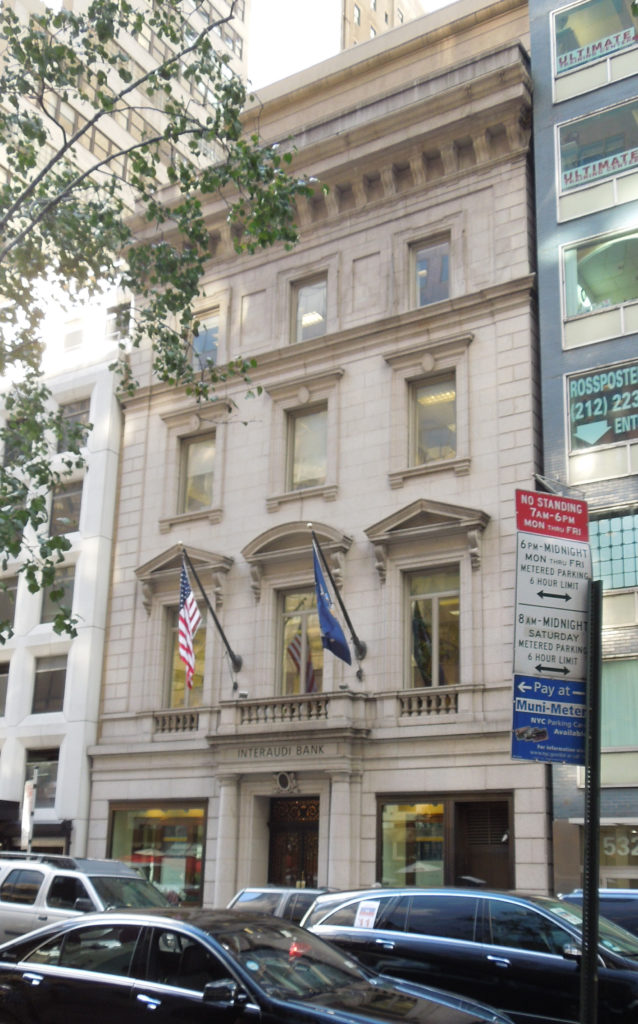
Item 4
LP – 2578
BOROUGH OF MANHATTAN, block 1291, lot 127
MARTIN ERDMANN RESIDENCE, 57 East 55th Street
This striking town house was designed by Taylor & Levi and completed in 1908-09 for Martin Erdmann, a successful banker who commissioned the house for his early retirement when he was only in his forties. In 1910, he lived here on his own income, with no family members, but with eight servants. Erdmann was born in New York, but his father was from Germany, which may explain the house’s unusual German Renaissance style design. The building is unlike any contemporary New York town house, with its gabled front, strapwork ornament and leaded windows. In 1909, an anonymous critic for the journal Architecture commented on just how unusual the façade was, noting that it was “conceived in so different a vein from most New York houses that its propriety can be questioned…but there is much in this house to awaken an intelligence lulled to sleep by monotonous repetition of classic forms.”
This is the only remaining house on what was once a residential block. It has been preserved since 1956 by The Friars Club, a club for actors. Club members refer to the building as “The Monastery.” The club was established in 1904 and in 1911 inaugurated the Friar Frolics, for which Irving Berlin wrote “Alexander’s Ragtime Band.” The club is best known to the public for its famous Celebrity Roasts, where famous performers joke about the guest of honor. Though not being considered for landmark status today, it is worth noting that many of Erdmann’s original interiors remain intact.
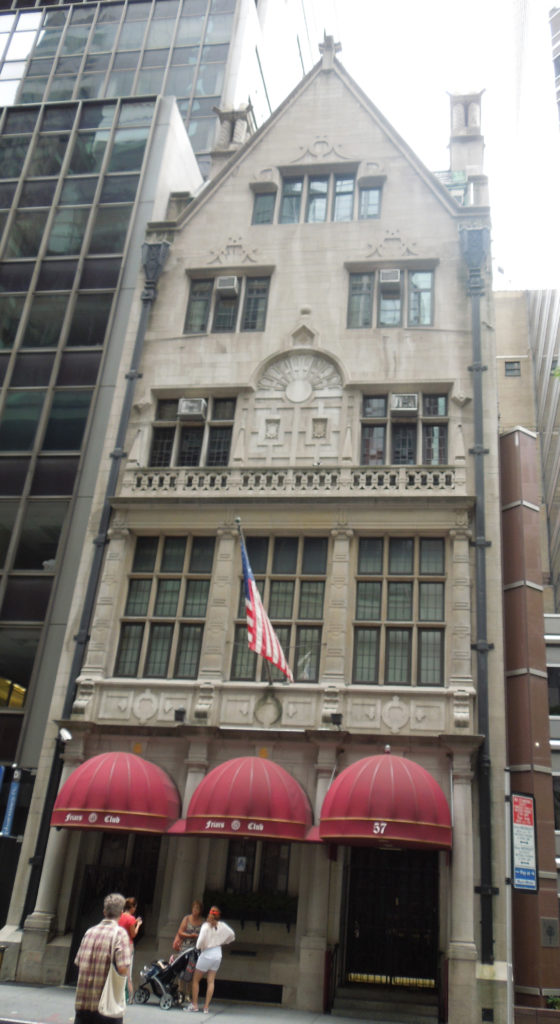
Item 5
LP – 2581
BOROUGH OF MANHATTAN, block 1275, Lot 61
18 EAST 41ST STREET BUILDING, 18-20 East 41st Street
In 1912, the architects George & Edward Blum received a commission for a twenty-story office building from the Holland Construction Company. Over the course of their prolific careers, the Blums created some of the most distinctive buildings in New York City, often employing a singular Arts-and-Crafts aesthetic that exploited the properties of ornamental terra cotta. Although the Blums are best known for their apartment houses, they were also responsible for a significant number of commercial office and loft buildings. The East 41st Street office building is one of their most unusual, given that it was designed in the neo-Gothic style. This choice of design, as well as the use of terra-cotta cladding, was likely inspired by the Woolworth Building, which was then under construction. Like the Woolworth, 18 East 41st Street’s terra-cotta is coated with a bright white glaze, with the recessed sections of the three dimensional façades highlighted with polychromy.
However, what makes the East 41st Street building so exceptional is the quality of the ornamental detail, which combines the Blums’ interest in using both organic and geometric forms. The façade is highlighted with spandrels, vertical bands, balconies and other features on which can be found twining vines with large leaves and what appear to be ripe figs ready for the picking. The Blums, who were of Alsatian descent, studied at the Ecole des Beaux-Arts in Paris and were familiar with progressive French ornamental design. They used one of their favorite French-inspired ornamental devices on this building – the naturalistic leaves that appear to lap over their frames. These organic design features are balanced on several of the Blums’ most important buildings with an overlay of geometric detail. This is evident here in the square grids that appear in many locations on the façade and in the geometric grids cut into the shield designs used on the projecting window balconies. The building has sustained a few alterations over the years, including the removal of its storefront, but has undergone an exceptionally sensitive restoration. Its striking features and commanding presence make it worthy of landmark status.
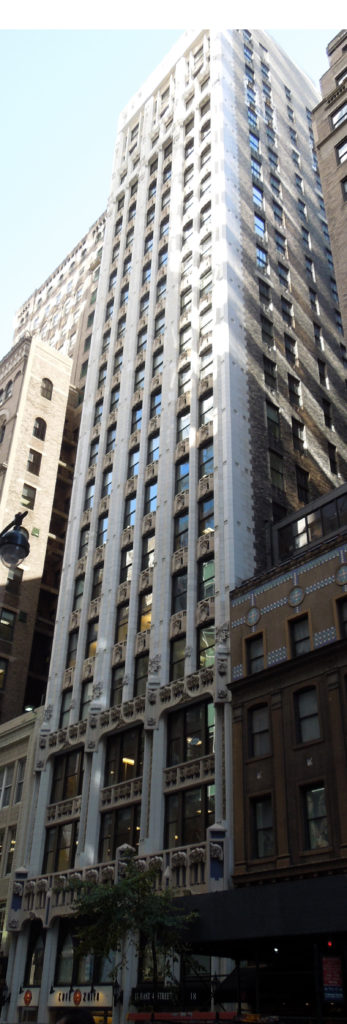
Item 6
LP – 2580
BOROUGH OF MANHATTAN, block 1285, lot 59
HAMPTON SHOPS BUILDING, 18-20 East 50th Street
The Hampton Shops Building, a well-preserved neo-Gothic skyscraper, is fully deserving of landmark status, not just on its own merits, but as a contextual backdrop for St. Patrick’s Cathedral. Designed by Rouse & Goldstone, with Joseph L. Steinman, the structure is an anomaly amongst the firm’s prolific catalogue in New York City. William L. Rouse and Lafayette A. Goldstone joined forces in 1909 and quickly made a name for themselves in designing grand apartment buildings. They were also known for their high level of skill at adapting Renaissance-inspired architecture to New York City’s skyscraper typology. Completed in 1916, the Hampton Shops Building is neither an apartment building nor a Renaissance Revival style building. For this commission, they considered the context of the new structure, directly across the street from the south façade of St. Patrick’s Cathedral, and chose grey terra-cotta cladding and gracious Gothic style ornament to complement their venerable neighbor. It is worth noting that in the designation report for the individually landmarked S. Jarmulowsky Bank Building, the LPC described both that structure and the Hampton Shops Building as “unique designs” for the firm of Rouse & Goldstone. It is only fitting, then, that this building, like the Jarmulowsky Bank, be granted landmark status. With its strong verticality, pointed arches and rich ornament, the building contributes to East Midtown’s history and sense of place, and should be celebrated and protected as such.

Item 7
LP – 2579
BOROUGH OF MANHATTAN, block 1279, lot 28
YALE CLUB OF NEW YORK CITY, 50 Vanderbilt Avenue
The original Yale Club of New York City opened on Madison Square in 1897. After moving to 30 West 44th street in 1901, the Club relocated permanently to 50 Vanderbilt Avenue in 1915. At that time, the Grand Central Terminal area was fast becoming the center of civic life in New York, and it made sense for a club catering to successful businessmen to be in the heart of it. Built across the street from the terminal shortly after its completion and on land owned by the New York & Harlem Railroad, the Yale Club is an important contextual component to the Grand Central area.
The 22-story “clubhouse,” seven bays wide along Vanderbilt and six bays deep along 44th Street, was designed by New York architect James Gamble Rogers. Rogers was known for not only revivalism but outright historicism in architecture, though he often relied on modern construction methods. The neo-classical Yale Club incorporates elements of the Italian Renaissance Revival. A massive five-story base of coursed limestone ashlar with rusticated joints supports fourteen stories of tan brick, topped by a double-height ballroom in the limestone-clad “capital,” consisting of round-arched windows flanked by monumental order which appears, from the ground, to be some version of Corinthian. The deeply overhanging roof remains intact, with copper modillions and anthemia visible, a rarity in buildings of this style and period.
In addition to this highly-visible commission, Rogers, a Yale alumnus, was responsible for extensive work at Yale’s New Haven campus. In 1917, shortly after completing the Yale Club, Gamble Rogers was commissioned by the university to master plan and redesign a significant and prominent part of Yale’s central campus, known as the Memorial Quadrangle, now Branford & Saybrook Colleges.

Item 8
LP – 2576
BOROUGH OF MANHATTAN, block 1283, lot 17
400 MADISON AVENUE BUILDING, 400 Madison Avenue
Constructed during the speculative building boom of the late 1920s, the 20-story office building at 400 Madison was one of several rental office buildings—in aggregate, over 3 million square feet of space—added to the particularly booming “Grand Central Zone” in 1929 alone. It replaced two six-story apartment buildings as the neighborhood was transformed into the business center of Manhattan. The unusual footprint, 188 feet long on Madison and only 44 feet deep along 47th & 48th Streets, allowed for extensive street frontage along the avenue, offering prime retail space. The second floor was originally designated for a bank, with upper floors rented out as commercial office space. A selling point of the design was that “[n]o portion of usable floor area will be more than 27 feet from a window,” and that no space was wasted with light wells or rear courts, efficiencies that would not have been lost on investors or renters. All service portions of the building were located along the rear wall, away from daylight.
The tiered upper stories of 400 Madison take advantage of the light & air zoning requirements to deploy a richly textured program of boldly geometric Gothic Revival-inspired terra cotta ornament, including crenellation, pinnacles and tracery elements topping an otherwise restrained façade. At street level, the original bronze and glass storefronts remain remarkably intact, a rarity in ever-changing Midtown. The unusual form of the building, masterfully turning an odd footprint into a selling feature based on natural light and retail frontage, coupled with the intactness of its elaborate terra-cotta decoration and street-level storefronts reflecting the boom years of the late 1920s in Midtown, qualify 400 Madison for consideration as a New York City Landmark.
Craig Severance studied in France before beginning to practice architecture in New York City around 1900. After a brief stint with Carrère & Hastings, Severance established his own practice in 1907. Severance partnered with William Van Alen between 1914 and the early 1920s, before returning to his own practice. In the 1920s, Severance became one of the most successful and well-known commercial architects in New York real estate circles. Just after designing 400 Madison, the architect engaged in what many observers of the period called the “altitude race” between Severance and his former partner, Van Alen, to build the tallest building in New York. Severance’s 1929 commission for 40 Wall Street was beaten out on a technicality by the spire of Van Alen’s 1930 Chrysler Building before the Empire State Building overtook both in 1931.
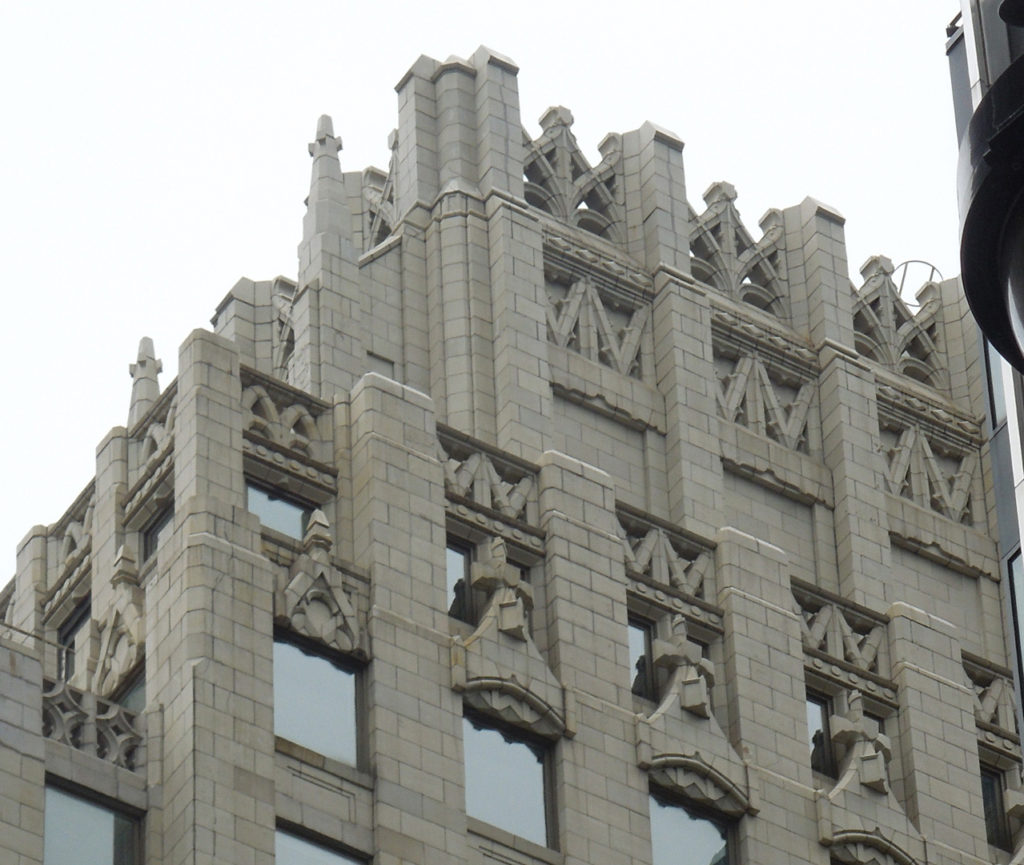
**Note regarding Item 9: 601 LEXINGTON AVENUE (FORMERLY THE CITICORP CENTER) AND ST. PETER’S LUTHERAN CHURCH
On September 13, the LPC is also considering the designation of 601 Lexington Avenue, formerly known as the Citicorp Center, designed by Hugh Stubbins with Emery Roth & Sons and built in 1977. In its classification for the 12 buildings it proposes to designate within the East Midtown Rezoning area, the LPC identified three categories: “pre-Grand Central Terminal”, “Terminal City”, and “post-Grand Central Terminal”. Only one building, Citicorp, falls within the final category, despite the presence of many significant mid-century office buildings in the area, and the inclusion of several of these on the LPC’s own list of eligible landmarks as part of the city’s Environmental Impact Statement. Even after the announcement of the 12 buildings to be designated, HDC continued to advocate for these mid-century buildings, but the LPC refuses to pursue any of them. HDC is dismayed by this oversight, especially since this inaction seems to be driven by real estate pressure.
While none of the city’s preservation advocates recommended the building for landmark status, the inclusion of Citicorp is not controversial in itself. The building is, after all, an iconic skyscraper and an important architectural record of 1970s New York. HDC is pleased to see it move forward toward designation. However, in the context of the buildings that are being left out of the LPC’s East Midtown action, Citicorp’s presence on the list looks like a token gesture in an attempt to appear inclusionary of all phases of the area’s history, when, in fact, there is a significant layer of roughly 50 years that will not be represented in this historic action. Had this building come forward for a hearing outside the context of the East Midtown Rezoning, HDC would have gladly advocated and testified on its behalf.



